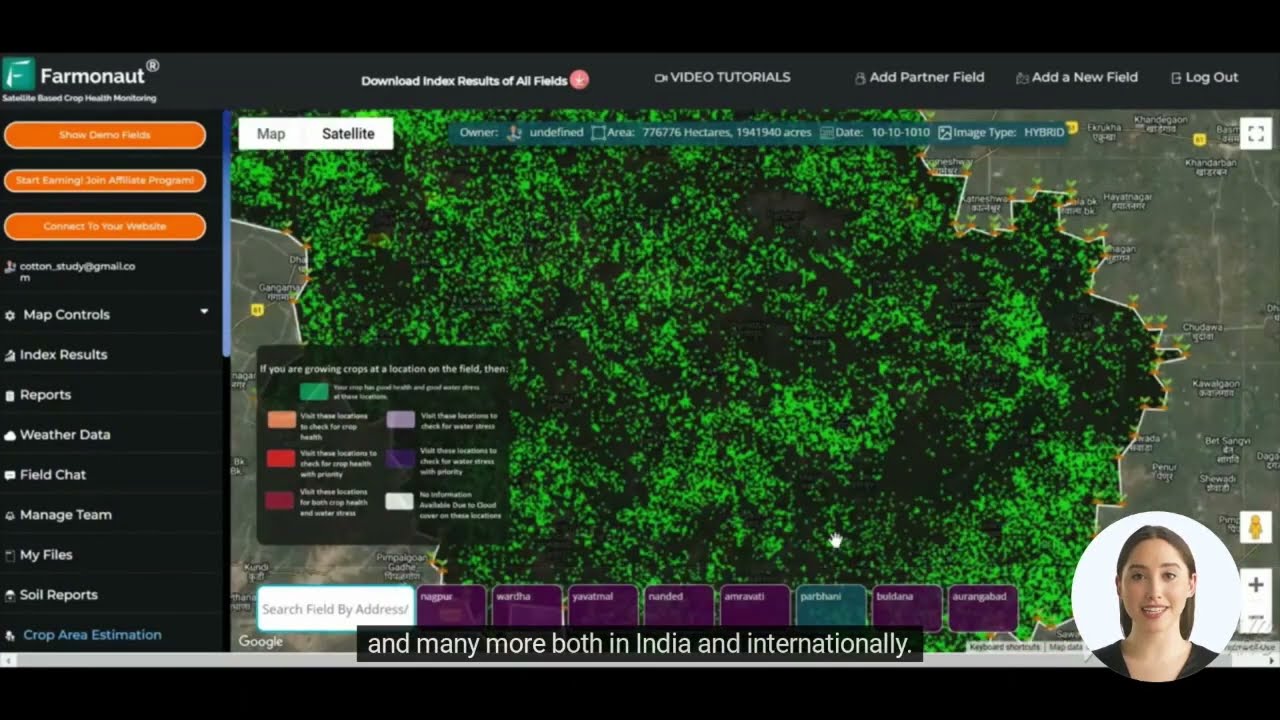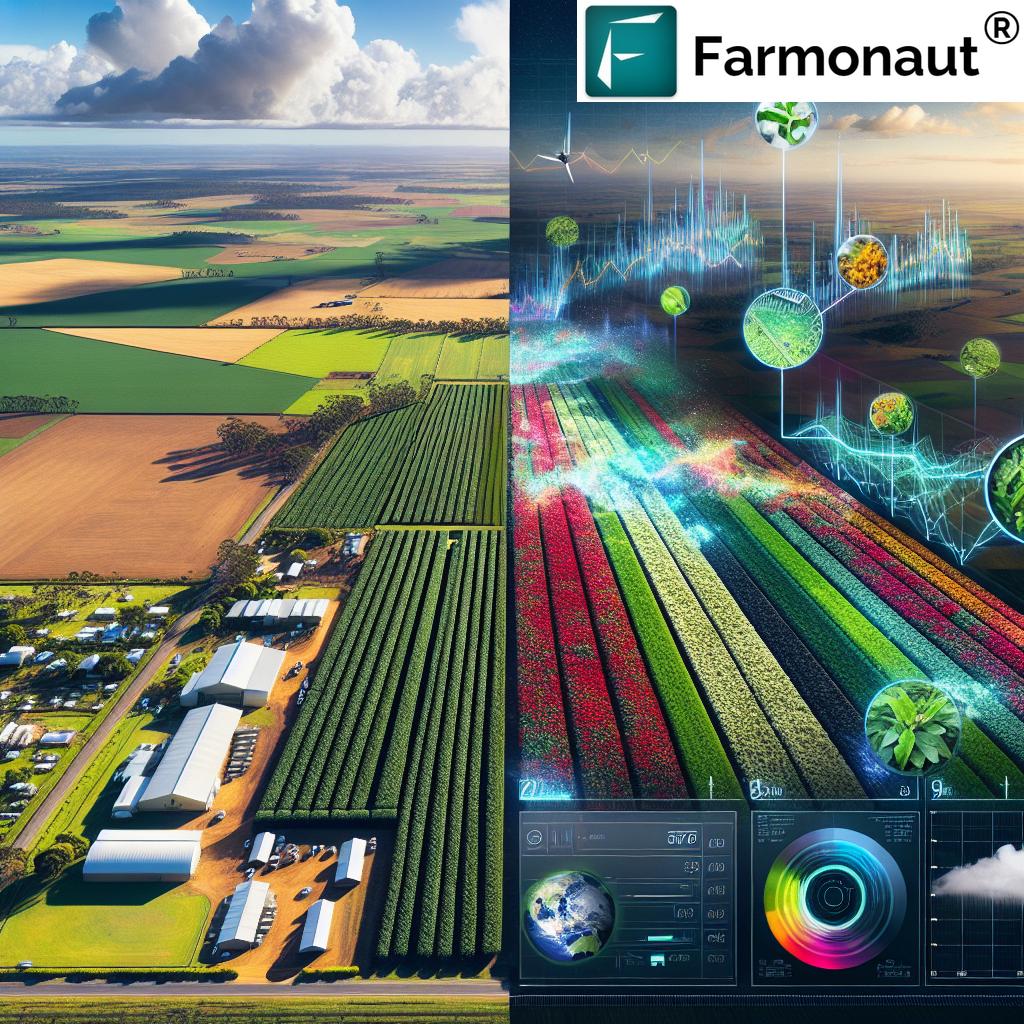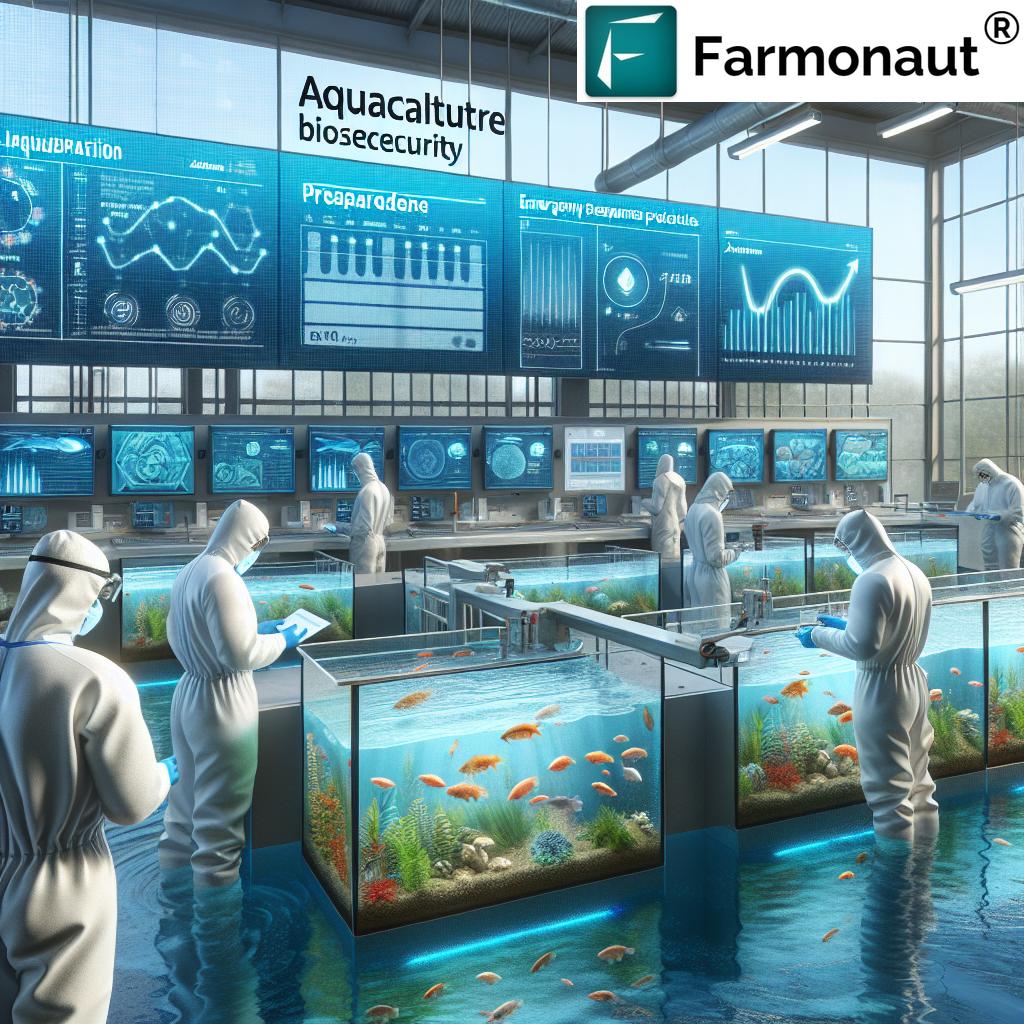Sustainable Fisheries Management in Australia: Farmonaut’s Guide to Aquaculture Best Practices and Marine Conservation
“Australia’s National Aquaculture Strategy aims to double the value of aquaculture production by 2027.”
Welcome to Farmonaut’s comprehensive guide on sustainable fisheries management and aquaculture best practices in Australia. As leaders in agricultural technology, we recognize the critical importance of balancing marine resource utilization with conservation efforts. In this blog post, we’ll explore Australia’s innovative approaches to fisheries and aquaculture, emphasizing biosecurity measures and conservation strategies that are shaping the future of the nation’s seafood industry.
The Importance of Sustainable Fisheries Management
Sustainable fisheries management is at the forefront of Australia’s efforts to protect marine ecosystems while supporting a thriving seafood industry. As a nation surrounded by vast oceans, Australia’s commitment to preserving its aquatic resources is paramount. Let’s delve into the multifaceted approach that ensures the long-term viability of its fisheries.
Australia’s National Aquaculture Strategy
The National Aquaculture Strategy is a cornerstone of Australia’s sustainable fisheries management. This comprehensive plan aims to:
- Boost aquaculture production
- Enhance biosecurity measures
- Promote innovation in the sector
- Ensure environmental sustainability
By implementing this strategy, Australia is paving the way for a robust and sustainable aquaculture industry that can meet growing demand while preserving marine ecosystems.
Sustainable Harvest Policies
Australia’s sustainable harvest policies are designed to maintain fish stocks at healthy levels. These policies are based on scientific research and consider factors such as:
- Population dynamics of fish species
- Ecosystem health
- Economic viability of fishing industries
By setting appropriate catch limits and implementing seasonal restrictions, these policies help prevent overfishing and ensure the long-term sustainability of marine resources.
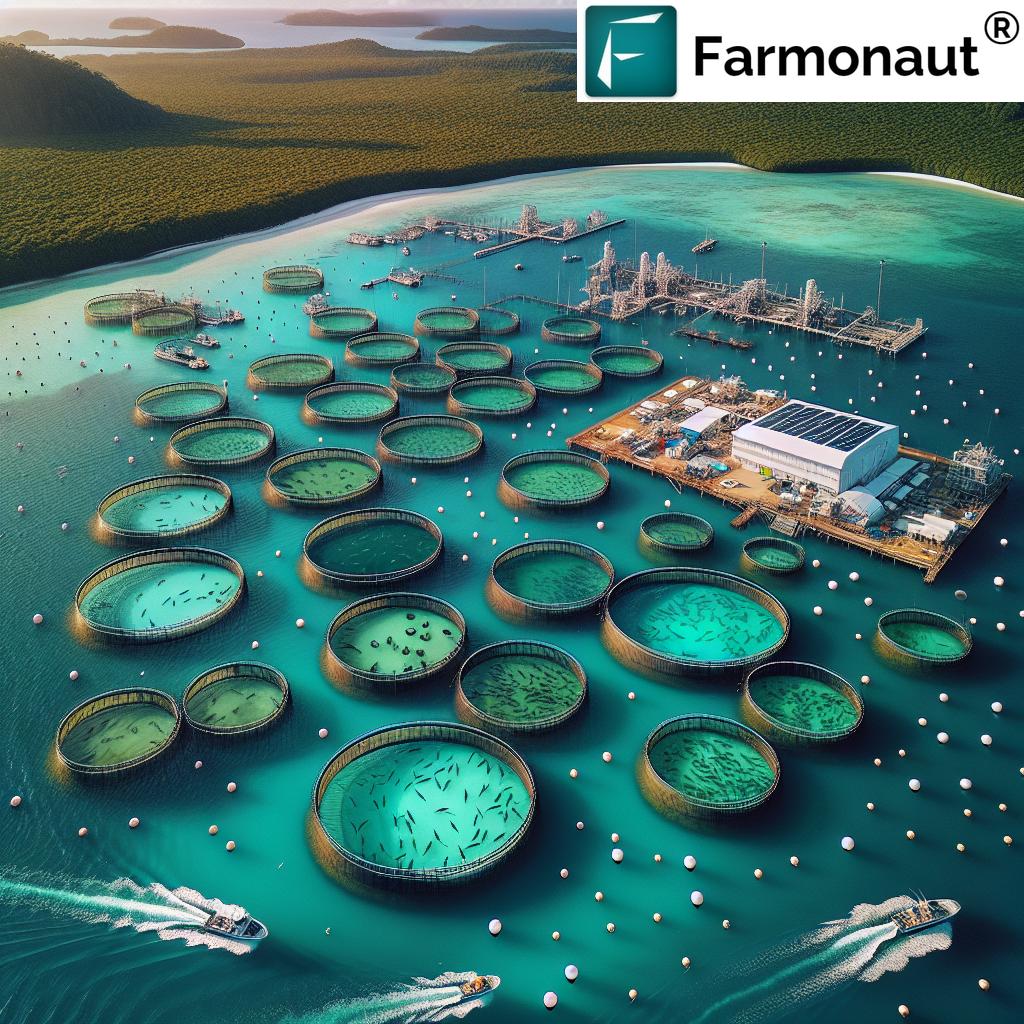
Innovative Approaches to Fisheries Management
Australia’s commitment to sustainable fisheries extends beyond traditional methods. The nation is at the forefront of implementing cutting-edge technologies and strategies to monitor and manage its aquatic resources effectively.
Fish Stock Monitoring Technology
Advanced fish stock monitoring technology plays a crucial role in Australia’s fisheries management. These technologies include:
- Satellite tracking of fishing vessels
- Acoustic surveys to estimate fish populations
- DNA analysis for species identification
At Farmonaut, we understand the importance of precise monitoring in resource management. Our satellite-based solutions, while primarily focused on terrestrial agriculture, can be adapted to support marine monitoring efforts. Our expertise in remote sensing and GIS technologies can potentially enhance the efficiency of fish stock monitoring programs.
Explore our advanced agricultural solutions: Farmonaut Web App
Combating Illegal, Unreported, and Unregulated (IUU) Fishing
Australia takes a strong stance against IUU fishing, which poses a significant threat to marine ecosystems and sustainable fisheries. The nation’s approach includes:
- Strict border protection measures
- International cooperation with neighboring countries
- Advanced surveillance technologies
These efforts help preserve fish stocks and protect the livelihoods of legitimate fishing operators.
Aquaculture Best Practices in Australia
Aquaculture is a rapidly growing sector in Australia, and the nation is committed to implementing best practices to ensure its sustainability and minimize environmental impact.
Biosecurity Measures in Aquaculture
Biosecurity is a critical aspect of sustainable aquaculture. Australia’s approach includes:
- Strict quarantine procedures for imported aquatic species
- Regular health monitoring of farmed fish
- Implementation of disease prevention strategies
These measures help protect both farmed and wild fish populations from the spread of diseases and invasive species.
Sustainable Feed Practices
Australia is pioneering sustainable feed practices in aquaculture, which include:
- Developing plant-based fish feeds to reduce reliance on wild-caught fish
- Optimizing feed formulations to minimize waste
- Exploring alternative protein sources, such as insect-based feeds
These practices not only reduce the environmental impact of aquaculture but also improve the overall sustainability of the industry.
Discover how Farmonaut’s technology can support sustainable farming practices: Android App | iOS App
Marine Conservation Strategies
“Australia’s marine parks cover 3.3 million square kilometers, approximately 36% of the country’s marine jurisdiction.”
Australia’s commitment to marine conservation is evident in its comprehensive network of marine protected areas and conservation initiatives.
Marine Protected Areas
Australia boasts one of the world’s largest networks of marine protected areas, including:
- The Great Barrier Reef Marine Park
- Coral Sea Marine Park
- Numerous coastal and offshore marine reserves
These protected areas play a crucial role in preserving biodiversity, supporting fish populations, and maintaining ecosystem health.
Bycatch Reduction Programs
Reducing bycatch is a key focus of Australia’s marine conservation efforts. Initiatives include:
- Development of more selective fishing gear
- Implementation of bycatch reduction devices
- Education programs for fishers on best practices
These programs help minimize the unintended capture of non-target species, including threatened and endangered marine life.
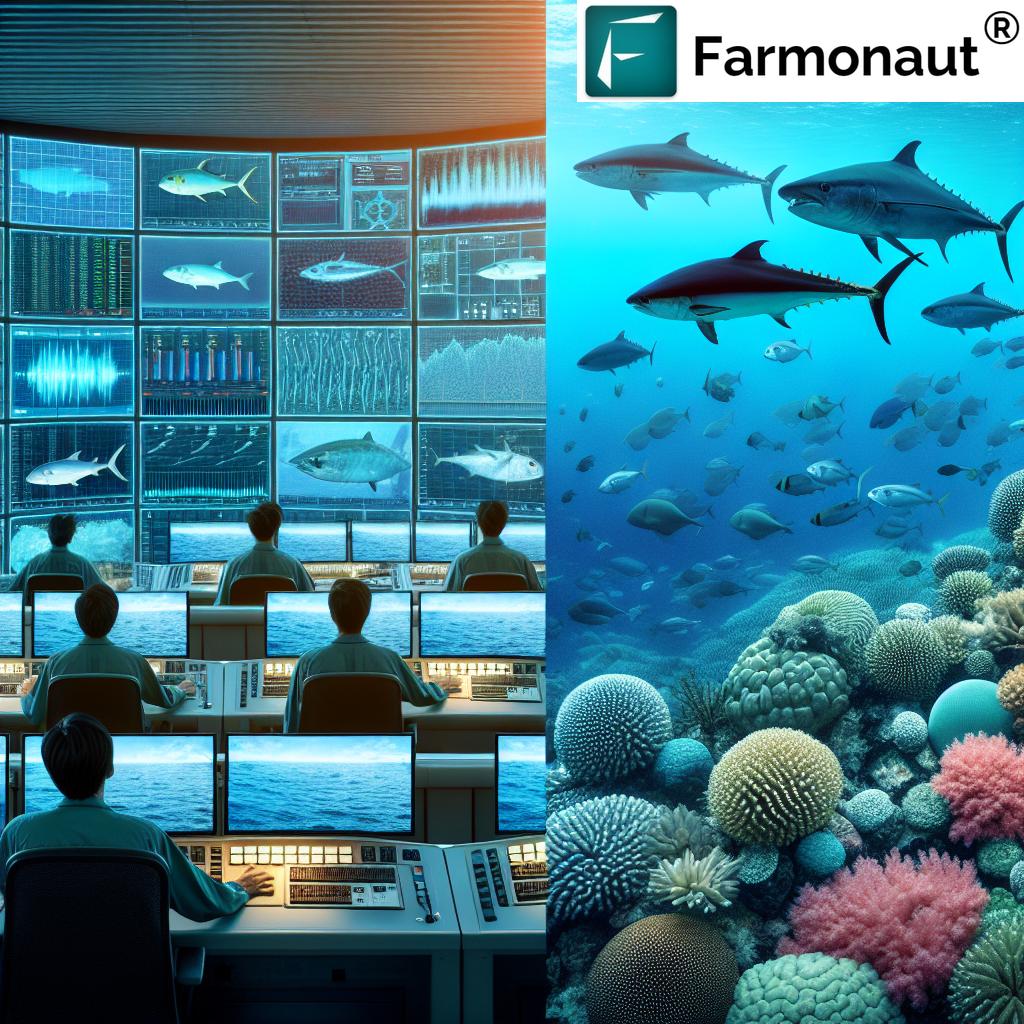
International Collaborations for Ocean Health
Australia recognizes that marine conservation is a global issue requiring international cooperation. The nation actively participates in various international initiatives, including:
- Regional Fisheries Management Organizations (RFMOs)
- The United Nations Convention on the Law of the Sea (UNCLOS)
- International Whaling Commission (IWC)
These collaborations help address transboundary issues such as migratory species protection and combating IUU fishing on a global scale.
Climate Change and Its Impact on Australian Fisheries
Climate change poses significant challenges to Australia’s marine ecosystems and fisheries. The nation is implementing various strategies to address these challenges, including:
- Research on climate-resilient aquaculture species
- Adaptation strategies for fishing communities
- Marine heatwave monitoring and response plans
By proactively addressing climate change impacts, Australia aims to ensure the long-term sustainability of its fisheries and aquaculture industries.
The Role of Technology in Sustainable Fisheries Management
Advanced technologies play a crucial role in Australia’s sustainable fisheries management. Some key technological applications include:
- Satellite-based vessel monitoring systems
- AI-powered image recognition for species identification
- Blockchain technology for seafood traceability
At Farmonaut, we recognize the potential of our agricultural technologies to contribute to sustainable fisheries management. Our expertise in satellite imagery analysis and AI-driven insights can be adapted to support marine monitoring efforts.
Learn more about our advanced agricultural technologies: Farmonaut API | API Developer Docs
Recreational Fishing Policies and Conservation
Recreational fishing is a popular activity in Australia, and the nation has implemented policies to ensure its sustainability. These policies include:
- Bag and size limits for popular fish species
- Seasonal closures to protect breeding populations
- Education programs on responsible fishing practices
By balancing conservation needs with recreational opportunities, Australia aims to preserve its marine resources for future generations.
Aquatic Farming Innovation
Innovation in aquatic farming is key to meeting the growing demand for seafood while minimizing environmental impact. Australia is at the forefront of developing sustainable aquaculture practices, including:
- Integrated multi-trophic aquaculture systems
- Offshore aquaculture technologies
- Recirculating aquaculture systems (RAS)
These innovative approaches help increase production efficiency while reducing the environmental footprint of aquaculture operations.
Sustainable Fisheries Management Practices in Australia
| Management Practice | Primary Objective | Implementation Area | Key Benefits | Challenges |
|---|---|---|---|---|
| National Aquaculture Strategy | Boost aquaculture production sustainably | Nationwide | Economic growth, food security | Balancing growth with environmental protection |
| Sustainable Harvest Policies | Maintain healthy fish stocks | All Australian fisheries | Long-term viability of fisheries | Adapting to climate change impacts |
| Fish Stock Monitoring Technology | Accurate assessment of fish populations | Coastal and offshore waters | Improved decision-making in fisheries management | High implementation costs |
| International Collaborations | Address global marine conservation issues | Regional and international waters | Coordinated efforts in combating IUU fishing | Aligning diverse national interests |
The Future of Sustainable Fisheries in Australia
As Australia continues to lead in sustainable fisheries management and aquaculture practices, several key areas will shape the future of the industry:
- Integration of AI and machine learning in fisheries management
- Development of climate-resilient aquaculture species
- Expansion of sustainable seafood certification programs
- Enhanced international cooperation for ocean conservation
These advancements will help ensure the long-term sustainability of Australia’s fisheries while meeting the growing global demand for seafood.
Farmonaut’s Contribution to Sustainable Resource Management
While Farmonaut’s primary focus is on terrestrial agriculture, our advanced technologies have the potential to support sustainable fisheries management and aquaculture practices. Our expertise in satellite-based monitoring, AI-driven insights, and resource management tools can be adapted to address challenges in the aquatic farming sector.
Some potential applications of Farmonaut’s technology in fisheries and aquaculture include:
- Satellite-based monitoring of coastal ecosystems
- AI-powered analysis of marine habitat health
- Resource optimization tools for aquaculture operations
- Blockchain-based traceability solutions for the seafood industry
By leveraging our advanced agricultural technologies, we aim to contribute to the sustainable management of both terrestrial and aquatic resources, supporting the global effort to ensure food security and environmental conservation.
Conclusion
Australia’s commitment to sustainable fisheries management and aquaculture best practices serves as a model for nations worldwide. By balancing economic interests with environmental conservation, Australia is paving the way for a future where thriving marine ecosystems coexist with a productive seafood industry.
As we at Farmonaut continue to innovate in the field of agricultural technology, we recognize the interconnectedness of terrestrial and aquatic ecosystems. Our mission to make precision agriculture accessible and affordable aligns with the broader goals of sustainable resource management, whether on land or at sea.
By embracing scientific research, implementing innovative technologies, and fostering international cooperation, Australia is ensuring that its rich marine resources will continue to support biodiversity, provide sustenance, and contribute to the national economy for generations to come.
FAQs
- What is sustainable fisheries management?
Sustainable fisheries management involves practices and policies that ensure the long-term viability of fish stocks while maintaining ecological balance and supporting economic activities. - How does Australia combat illegal fishing?
Australia combats illegal fishing through strict border protection measures, international cooperation, advanced surveillance technologies, and severe penalties for offenders. - What role does aquaculture play in Australia’s seafood industry?
Aquaculture is a growing sector in Australia, contributing significantly to seafood production and playing a crucial role in meeting the increasing demand for seafood while reducing pressure on wild fish stocks. - How is climate change affecting Australian fisheries?
Climate change is impacting Australian fisheries through rising sea temperatures, ocean acidification, and changing marine ecosystems, necessitating adaptive management strategies and research into climate-resilient species. - What are some key technologies used in Australian fisheries management?
Key technologies include satellite-based vessel monitoring systems, AI-powered species identification, acoustic surveys for fish population estimates, and blockchain technology for seafood traceability.




